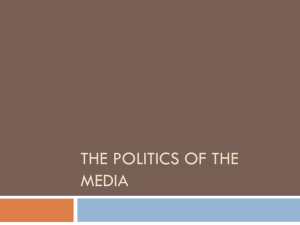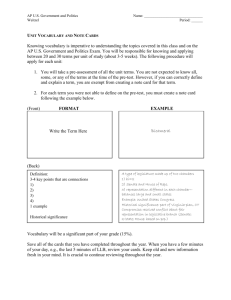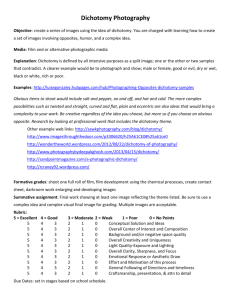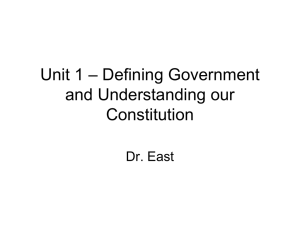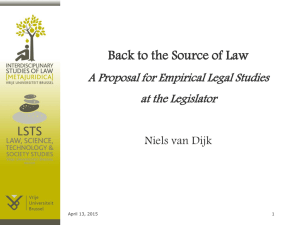PAD190 PRINCIPLES OF PUBLIC ADMINISTRATION
advertisement
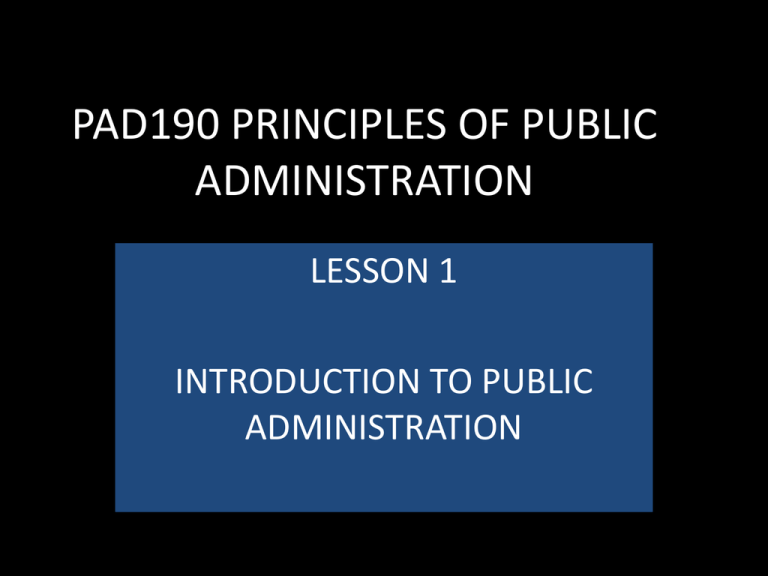
PAD190 PRINCIPLES OF PUBLIC ADMINISTRATION LESSON 1 INTRODUCTION TO PUBLIC ADMINISTRATION THE OBJECTIVES OF THIS LESSON After attended this lecture student should be able to:1. Define public administration 2. Identify the significance and characteristics of public administration 3. Explain what is policy and administration 4. Explain the principles of political administrative dichotomy 5. Explain the difference of public and private administration 6. Describe the role of public administration INTRODUCTION General statements on public administration • Public administration is one of the most significance administrative machinery in a particular state or country. • Public administration play very important roles in determining the nation’s affairs and progress. • Public administration work together with private administration in managing the state or nation-building. • The office of Public administration is different with political office. • Public administration is consist of various components. • Public administration is the government machinery to carry out certain objectives with a variety of tools; such policy, regulation, direct and indirect services to public. • Public administration refers to the activity of governmental unit in carrying out the public policy declared in the law. WHAT IS PUBLIC ADMINISTRATION? Definition of public administration Public administration is the branch of government that is responsible for the execution or implementation of policy . Public administration is the set of organization, rules and laws that ensure the intentions of the elected legislature are carried out through their laws. Public administration - Establishments of federal, provincial and municipal governments primarily engaged in activities associated with public administration. This includes such establishments such as the Federal Public Service, National Defense, RCMP and provincial and local administrations. As an instrument of the state in assisting citizens . Public administration is the detailed and systematic application of law. Every particular application of law is an act of administration (Woodrow Wilson) Public Administration is meant, in common usage, the activities of the executive branches of national, state and local governments, government corporations and certain other agencies of a specialised character. Specifically excluded are judicial and legislative agencies within the government and non-governmental administration ( H. A Simon) The Significance of Public administration • Enhancing civil society, ensuring a well-run, fair, and effective public service. • Improving equality, justice, security, efficiency, effectiveness of public services usually in a nonprofit, non-taxable venue. • Maintaining law and order. • Promoting peace and harmony. • Protecting the interests of the state and of the people . • Practicing Good governance - transparency and accountability in government policy decision making and implementation process. The characteristics of Public Administration The characteristics of public administration in the democratic context are:Non-partisan or Neutrality – public administration is a non-political administrative apparatus that is subject to policy direction but not partisan. Structure - A set of laws or legally founded rules that create the structure of the administrative apparatus of the state. Power – public administration has given certain authority to draw and implement policy to achieve the desired goal. Activities – public administration carry out activities that related to the government Supervision - Continuing democratic supervision of administrative activities through the executive which directs activities within public administration apparatus. Personnel – public administration is carried out by public servants who work in public departments and agencies, at all levels of government, and perform a wide range of tasks. What is Policy and administration? Policy - is a deliberate plan of action to guide decisions and achieve rational outcome(s). Policies can be understood as political, management, financial, and administrative mechanisms arranged to reach explicit goals. Policy merely guides actions toward those that are most likely to achieve a desired outcome. Administration – is described as the implementation of government policy carried out by peoples who work in that organization or agencies and perform various tasks. Policy and administration is two interconnected activities that relevant to public administration and the government administrative process. Public administration is working on policy that decided by the government to achieve certain desired goals. The principles of political administrative dichotomy • a principle stating that politics and administration should remain separate in the public sector. • Politics is a process by which groups of people make decisions on political interests. They are elected through election process which involves, normally several political parties. It is achieved to satisfy political interests. • Administration is a process by which groups of people make decisions on public interests. They are appointed by the government to implement political decisions of the lead government. • The idea of separating politics and administration is to avoid conflict of interest and maintaining neutrality (Max Weber) • According to David H. Rosenbloom - the idea that public administration can be separated from politics is strange. He Public and private administration Two different sectors or entities Example : Public administration – public school or hospital Private administration – private school or hospital Both are providing same services to people and aim to achieve same objective. However, there are few differences of these two organizations. The differences of public and private administration • Setting – how these two organizations was set up? • Staffing– how the recruitment and training of the personnel and their conditions of work? • Mission/goal – What is the mission and goal? • Operation/work procedures – How the procedures used in these organizations.? • Funding – How the financing of the activities? • Decision making process – How decisions are made? • Visibility /accountability – subject to whom? PUBLIC VS PRIVATE PUBLIC • Created by the government/public • Constitution set the formation • Funded by taxes/public budget. • Not for profit motive. • Controlled by legislative & judiciary. • Public services/Do not pay taxes PRIVATE • Owned by private/individual or group • Subject to company law • Funded by investor capital/share • Profits motive • Controlled by the board • Pay taxes • Engage in various business activities SCOPE OF PUBLIC ADMINISTRATION By the scope of Public Administration, we mean the major concerns of Public Administration as an activity and as a discipline. • Public administration covers every area and activity within the ambit public policy. Thus, the scope of public administration is very wide in modern state. • Public administration is any kind of administration in the public interest which has simply come to mean governmental administration. There are many views regarding the scope and range of activities to be included in public administration. Some thinkers take a broader view and include all governmental activities having for their purpose, the fulfillment of public policy, while other take a narrow view and consider only those activities concerned with the executive branch of government as a part of public administration. The Role of Public Administration Public administration plays very important role in any country. The role of public administration is changing from being a major provider of public services and development to promoter and facilitator of development. • Implementing government policies - Public administration has important role to play in translating the ideas, wishes and policies of politicians into reality. • Providing Public services – public administration provide varieties of services directly or indirectly through its agencies. Such services including provision of water, education, health, electricity, telephone, postal, transport, public housing, immigration and security services. • Improving Service delivery – improving service delivery in term of timeliness, quality, availability, effectiveness, efficiency and convenience. This can be achieved by considering citizens as customer and success is measured in terms of citizens’ satisfaction. • Promoting social change and economic development – improving socio-economic status of citizens and alleviating poverty. • Maintaining peace and harmony - Public administration is a major force for bringing stability in society. • Monitoring and control private sector activities - Public administrationis also regulate and control private economic enterprises to meet the objectives of the state. • Protecting of the rights of workers in industrial sector - it is imperative for public administration to implement such laws in order to meet the requirements of labour welfare. • Scientific and technological developments – bringing new techonologies for administration such as the advancement of e-goverment. • Economic planning - Centralised economic planning has been pursued in many developing countries as a method for socio-economic development. It requires a large number of experts and elaborate administrative machinery for plan formulation, implementation, monitoring, and evaluation. CONCLUSION The Concept of Public Administration • is co-operative group effort in a public setting; • covers all three branches-executive, legislative, and judicial, and their inter-relationships; • has an important role in the formulation and implementation of public policy and is thus a part of the administrative process; • is different in significant ways from private administration; • is closely associated with numerous private groups and individuals in providing services to the community”. • is the non-political public bureaucracy operating in a political system; • deals with the ends of the State, the sovereign will, the public interests and laws; • is the business side of government and as such concerned with policy execution, but it is also concerned with policy-making; • covers all three branches of government, although it tends to be concentrated in the executive branch; • provides regulatory and service functions to the people in order to attain good life; • differs significantly from private administration, especially in its emphasis on the public; and • is interdisciplinary in nature as it draws upon other social sciences like political science, economics and sociology. to the community”. Major ? Should be discussed in tutorial • What is public administration? • What are the significance and characteristics of public administration? • What is the principle of political administrative dichotomy? • What is the difference of public and private administration? • What are the roles of public administration? THAT ALL FOR TODAY SEE YOU AGAIN NEXT LECTURE LESSON 2 “HISTORY AND DEVELOPMENT OF PUBLIC ADMINISTRATION” THANK YOU

